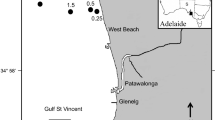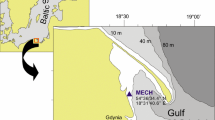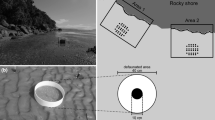Abstract
Rafting on biotic and abiotic substrata has been reported for many benthic marine invertebrates. Here, I describe important characteristics of common floating substrata and review published studies examining the succession of the assemblage on detached macroalgae to identify the most important factors determining this succession. Floating substrata differ in survival time (i.e. before they disintegrate) and in food value, with abiotic materials having high survival times but low food value and some biotic substrata (seagrasses, fresh wood) having high food values but short survival times. Large macroalgae with pneumatocysts may combine high survival times and high food values. Substratum survival and food value have consequences for the species composition of the rafting macrofauna. In general, suspension feeders dominate rafting assemblages on abiotic substrata, while grazing and boring species abound on macroalgae and wood. The succession of the rafting assemblage can be subdivided into three phases during which different processes predominate. During the initial phase some of the original colonizers (if present) disappear from the substratum, either due to active emigration or predation. This short, initial phase is followed immediately by the colonization phase, during which new organisms colonize the rafting substratum. Colonization may be rapid and intense in the beginning but then slows down. Towards the end of the colonization phase, some rafting organisms may reproduce and their offspring recruit within the parental raft. Results from two long-term studies confirmed that the proportion of species with direct development increased with duration of rafting. These successional changes will be most pronounced for large biotic substrata, rendering these particularly suitable for long-distance dispersal of organisms with direct development.
Similar content being viewed by others
References
Barnes, D. K. A., 2002. Invasions by marine life on plastic debris. Nature 416: 808–809.
Barnes, D. K. A. & W. G. Sanderson, 2000. Latitudinal patters in the colonization of marine debris. In Herrera Cubilla, A. & J. B. C. Jackson (eds), Proceedings of the 11th International Bryozoology Association Conference. Smithsonian Tropical Research Institute, Balboa, R.P.: 145–153.
Brooks, R. A. & S. S. Bell, 2001. Mobile corridors in marine landscapes: enhancement of faunal exchange at seagrass/sand ecotones. J. exp. mar. Biol. Ecol. 264: 67–84.
Castilla, J. C. & R. Guiñez, 2000. Disjoint geographical distribution of intertidal and nearshore benthic invertebrates in the Southern Hemisphere. Rev. Chil. Hist. Nat. 73: 583–603.
Davenport, J. & E. I. S. Rees, 1993. Observations on neuston and floating weed patches in the Irish Sea. Estuar. coast. shelf Sci. 36: 395–411.
Dayton, P. K., V. Currie, T. Gerrodette, B. Keller, R. Rosenthal & D. van Tresca, 1984. Patch dynamics and stability of some California kelp communities. Ecol. Monogr. 54: 253–289.
Deudero, S. & B. Morales-Nin, 2000. Occurrence of Polyprion americanus under floating objects in western Mediterranean oceanic waters, inference from stomach content analysis. J. mar. biol. Ass. U.K. 80: 751–752.
Ebbesmeyer, C. C. & J. W. Ingraham, Jr., 1992. Shoe Spill in the North Pacific. EOS, Trans. am. Geophys. Union 73: 361–368.
Edgar, G. J., 1987. Dispersal of faunal and floral propagules associated with drifting Macrocystis pyrifera plants. Mar. Biol. 95: 599–610.
Garrity, S. D. & S. C. Levings, 1993. Marine debris along the Caribbean coast of Panama. Mar. Poll. Bull. 26: 317–324.
Greene, C. H. & A. Schoener, 1982. Succession on marine hard substrata: a fixed lottery. Oecologia 55: 289–297.
Gutow, L., 2003. Local population persistence as a pre-condition for large-scale dispersal of Idotea metallica (Crustacea: Isopoda) on drifting habitat patches. Hydrobiologia, 503 (Dev. Hydrobiol. 174): 45–48.
Gutow, L. & H. D. Franke, 2001. On the current and possible future status of the neustonic isopod Idotea metallica Bosc in the North Sea: a laboratory study. J. Sea Res. 45: 37–44.
Gutow, L. & H. D. Franke, 2003. Metapopulation structure of the marine isopod Idotea metallica - a species associated with drifting habitat patches. Helgol. mar. Res. 56: 259–264.
Harrold, C. & S. Lisin, 1989. Radio-tracking rafts of giant kelp: local production and regional transport. J. exp. mar. Biol. Ecol. 130: 237–251.
Helmuth, B, R. R. Veit & R. Holberton, 1994. Long-distance dispersal of a SubAntarctic brooding bivalve (Gaimardia trapesina) by kelp rafting. Mar. Biol. 120: 421–426.
Hirata, T., J. Tanaka, T. Iwami, T. Ohmi, A. Dazai, M. Aoki, H. Ueda, Y. Tsuchiya, T. Sato & Y. Yokohama, 2001. Ecological studies on the community of drifting seaweeds in the southeastern coastal waters of Izu Peninsula, central Japan. I. Seasonal changes of plants in species composition, appearance, number of species and size. Phycol. Res. 49: 215–229.
Hobday, A. J., 2000a. Persistence and transport of fauna on drifting kelp (Macrocystis pyrifera (L.) C. Agardh) rafts in the Southern California Bight. J. exp. mar. Biol. Ecol. 253: 75–96.
Hobday, A. J., 2000b. Age of drifting Macrocystis pyrifera (L.) C. Agardh rafts in the Southern California Bight. J. exp. mar. Biol. Ecol. 253: 97–114.
Hobday, A. J., 2000c. Abundance and dispersal of drifting kelp Macrocystis pyrifera rafts in the Southern California Bight. Mar. Ecol. Prog. Ser. 195: 101–116.
Holloway, M. G. & S. D. Connell, 2002. Why do floating structures create novel habitats for subtidal epibiota? Mar. Ecol. Prog. Ser. 235: 43–52.
Hunter, J. R. & C. T. Mitchell, 1967. Association of fishes with flotsam in the offshore waters of Central America. Fish. Bull. 66: 13–29.
Ingólfsson, A., 1995. Floating clumps of seaweed around Iceland: natural microcosms and a means of dispersal for shore fauna. Mar. Biol. 122: 13–21.
Ingólfsson, A., 1998. Dynamics of macrofaunal communities of floating seaweed clumps off western Iceland: a study of patches on the surface of the sea. J. exp. mar. Biol. Ecol. 231: 119–137.
Ingólfsson, A., 2000. Colonization of floating seaweed by pelagic and subtidal benthic animals in south-western Iceland. Hydrobiologia 440: 181–189.
Ingólfsson, A. & B. K. Kristjánsson, 2002. Diet of juvenile lumpsucker Cyclopterus lumpus (Cyclopteridae) in floating seaweed: effects of ontogeny and prey availability. Copeia 2002: 472–476.
Jokiel, P. L., 1989. Rafting of reef corals and other organisms at Kwajalein Atoll. Mar. Biol. 101: 483–493.
Kingsford, M. J., 1992. Drift algae and small fish in coastal waters of northeastern New Zealand. Mar. Ecol. Prog. Ser. 80: 41–55.
Kingsford, M. J., 1995. Drift algae: a contribution to near-shore habitat complexity in the pelagic environment and an attractant for fish. Mar. Ecol. Prog. Ser. 116: 297–301.
Kingsford, M. J. & J. H. Choat, 1985. The fauna associated with drift algae captured with a plankton-mesh purse seine net. Limnol. Oceanogr. 30: 618–630.
Matsumura, S. & K. Nasu, 1997. Distribution of floating debris in the North Pacific Ocean: Sighting Surveys 1986-1991. In Coe, J. M. & D. B. Rogers (eds), Marine Debris: Sources, Impacts, and Solution. Springer, New York: 15–24.
Minchin, D., 1996. Tar pellets and plastics as attachment surfaces for lepadid cirripedes in the North Atlantic Ocean. Mar. Poll. Bull. 32: 855–859.
Morgan, S. G., 2001. The larval ecology of marine communities. In Bertness, M. D., S. D. Gaines & M. E. Hay (eds), Marine Community Ecology. Sinauer Associates, Sunderland, Massachusetts: 159–181.
Ó Foighil, D., B. A. Marshall, T. J. Hilbish & M. A. Pino, 1999. Trans-pacific range extension by rafting is inferred for the flat oyster Ostrea chilensis. Biol. Bull. 196: 122–126.
Ó Foighil, D., R. Jennings, J.-K. Park & D. A. Merriwether, 2001. Phylogenetic relationships of mid-oceanic ridge and continental lineages of Lasaea spp. (Mollusca: Bivalvia) in the northeastern Atlantic. Mar. Ecol. Prog. Ser. 213: 165–175.
Relini, G., M. Relini, L. Relini Orsi & M. Montanari, 2000. An offshore buoy as a small artificial island and a fish aggregating device (FAD) in the Mediterranean. Hydrobiologia 440: 65-80
Roughgarden, J., S. Gaines & H. Possingham, 1987. Recruitment dynamics in complex life-cycles. Science 241: 1460–1466.
Safran, P. & M. Omori, 1990. Some ecological observations on fishes associated with drifting seaweed off Tohoku coast, Japan. Mar. Biol. 105: 395–402.
Seymour, R. J., M. J. Tegner, P. K. Dayton & P. E. Parnell, 1989. Storm wave induced mortality of giant kelp, Macrocystis 57 pyrifera, in southern California. Estuar. coast. shelf Sci. 28: 277–292.
Shaffer, J. A., D. C. Doty, R. M. Buckley & J. E. West, 1995. Crustacean community composition and trophic use of the drift vegetation habitat by juvenile splitnose rockfish Sebastes diploproa. Mar. Ecol. Prog. Ser. 123: 13–21.
Si, A., C. G. Alexander & O. Bellwood, 2000. Habitat partitioning by two wood-boring invertebrates in a mangrove system in tropical Australia. J. mar. biol. Ass. U.K. 80: 1131–1132.
Smith, S. D. A., 2002. Kelp rafts in the Southern Ocean. Global Ecol. Biogeogr. 11: 67–69.
Sponer, R. & M. S. Roy, 2002. Phylogeographic analysis of the brooding brittle star Amphipholis squamata (Echinodermata) along the coast of New Zealand reveals high cryptic genetic variation and cryptic dispersal potential. Evolution 56: 1954–1967.
Svane, I. & J. K. Petersen, 2001. On the problems of epibioses, fouling and artificial reefs, a review. Mar. Ecol. 22: 169–188.
Tsikhon-Lukanina, E. A., O. G. Reznichenko & G. G. Nikolaeva, 2001. Ecology of invertebrates on the oceanic floating substrata in the Northwest Pacific Ocean. Oceanology 41: 525–530.
Tuente, U., D. Piepenburg & M. Spindler, 2002. Occurrence and settlement of the common shipworm Teredo navalis (Bivalvia: Teredinidae) in Bremerhaven harbours, northern Germany. Helgol. mar. Res. 56: 87–94.
Vásquez, J. A., 1993. Effects on the animal community of dislodgement of holdfasts of Macrocystis pyrifera. Pac. Sci. 47: 180–184.
Wahl, M., 1997. Living attached: Aufwuchs, fouling, epibiosis. In: Nagabhushanam, R. & M.-F. Thompson (eds), Fouling Organisms of the Indian Ocean: Biology and Control Technology. Oxford & IBH Publ Co, New Delhi: 31–84.
Williams, A. T. & D. T. Tudor, 2001. Litter burial and exhumation: spatial and temporal distribution on a cobble pocket beach. Mar. Poll. Bull. 42: 1031–1039.
Winston, J. E., 1982. Drift Plastic - an expanding niche for a marine invertebrate?. Mar. Poll. Bull. 13: 348–351.
Winston, J. E., M. R. Gregory & L. M. Stevens, 1997. Encrusters, epibionts, and other biota associated with pelagic plastics: a review of biogeographical, environmental, and conservation issues. In Coe, J. M. & D. B. Rogers (eds), Marine Debris: Sources, Impacts, and Solution. Springer, New York: 81–97.
Witman, J. D., 1987. Subtidal coexistence: storms, grazing, mutualism, and the zonation of kelp and mussels. Ecol. Monogr. 57: 167–187.
Ye, S. & A. L. Andrady, 1991. Fouling of floating plastic debris under Biscayne Bay exposure conditions. Mar. Poll. Bull. 22: 608–613.
Author information
Authors and Affiliations
Rights and permissions
About this article
Cite this article
Thiel, M. Rafting of benthic macrofauna: important factors determining the temporal succession of the assemblage on detached macroalgae. Hydrobiologia 503, 49–57 (2003). https://doi.org/10.1023/B:HYDR.0000008486.37391.60
Issue Date:
DOI: https://doi.org/10.1023/B:HYDR.0000008486.37391.60




